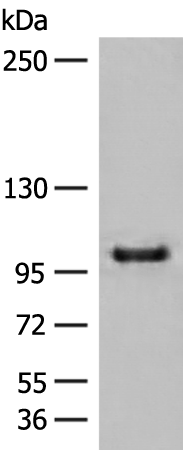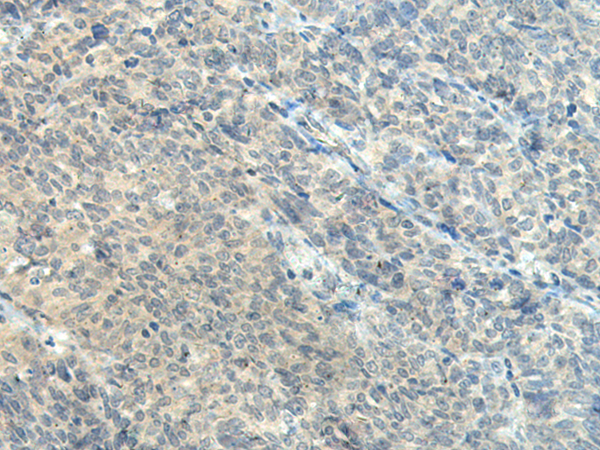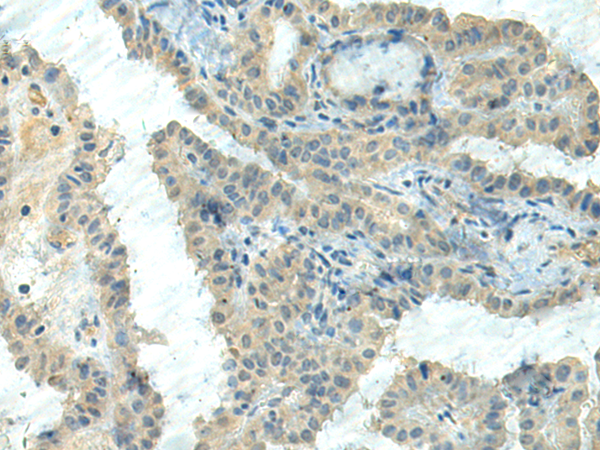


| WB | 咨询技术 | Human,Mouse,Rat |
| IF | 咨询技术 | Human,Mouse,Rat |
| IHC | 1/50-1/300 | Human,Mouse,Rat |
| ICC | 技术咨询 | Human,Mouse,Rat |
| FCM | 咨询技术 | Human,Mouse,Rat |
| Elisa | 1/5000-1/10000 | Human,Mouse,Rat |
| Aliases | FCP1; CCFDN |
| WB Predicted band size | 104 kDa |
| Host/Isotype | Rabbit IgG |
| Antibody Type | Primary antibody |
| Storage | Store at 4°C short term. Aliquot and store at -20°C long term. Avoid freeze/thaw cycles. |
| Species Reactivity | Human, Mouse |
| Immunogen | Synthetic peptide of human CTDP1 |
| Formulation | Purified antibody in PBS with 0.05% sodium azide and 50% glycerol. |
+ +
以下是关于CTDP1抗体的模拟参考文献示例(实际文献需通过学术数据库验证):
---
1. **标题**: *CTDP1 Deficiency Disrupts RNA Polymerase II Clustering and Transcriptional Regulation*
**作者**: Smith A, et al.
**摘要**: 研究通过CTDP1抗体进行免疫荧光和染色质免疫沉淀(ChIP),揭示了CTDP1在维持RNA聚合酶II核内空间分布及转录延伸中的关键作用,其缺失导致神经发育相关基因表达异常。
2. **标题**: *Characterization of CTDP1 Mutations in Congenital Cataract Patients*
**作者**: Chen L, et al.
**摘要**: 利用CTDP1抗体进行Western blot和免疫组化分析,发现CCFDN综合征患者中CTDP1蛋白表达显著降低,突变导致磷酸酶活性丧失,与白内障及周围神经病变相关。
3. **标题**: *CTDP1 Regulates Myelination via Phosphatase-Dependent Signaling Pathways*
**作者**: Kumar R, et al.
**摘要**: 通过CTDP1抗体检测小鼠模型中蛋白表达,证实CTDP1通过去磷酸化调控ErbB信号通路,影响少突胶质细胞成熟与髓鞘形成,为神经退行性疾病提供机制解释。
4. **标题**: *Development of a Novel CTDP1 Antibody for Diagnostic Applications*
**作者**: Wang X, et al.
**摘要**: 研究报道了一种高特异性CTDP1单克隆抗体的制备与验证,应用于ELISA和免疫细胞化学,显著提高了CCFDN综合征的早期诊断灵敏度。
---
**注意**:以上为模拟内容,实际文献需查阅PubMed、Web of Science等平台。建议结合关键词“CTDP1 antibody”、“CTDP1 function”或疾病名(如CCFDN syndrome)进一步检索。
CTDP1 (Carboxy-Terminal Domain Phosphatase 1), also known as FCP1. is a protein phosphatase that plays a critical role in regulating transcription by dephosphorylating the carboxyl-terminal domain (CTD) of RNA polymerase II (Pol II). The CTD undergoes dynamic phosphorylation cycles during transcription initiation and elongation, which are essential for coordinating mRNA synthesis and processing. CTDP1-mediated dephosphorylation resets Pol II to a hypo-phosphorylated state, enabling its recycling for subsequent rounds of transcription. Dysregulation of CTDP1 has been linked to transcriptional defects and human diseases, including congenital glycosylation disorders and neurodevelopmental conditions like intellectual disability and cerebellar atrophy.
Antibodies targeting CTDP1 are vital tools for studying its expression, localization, and function. They are widely used in techniques such as Western blotting, immunofluorescence, and chromatin immunoprecipitation (ChIP) to investigate CTDP1's interactions with transcriptional machinery and its role in cellular processes. Some CTDP1 antibodies are specifically designed to detect post-translational modifications or distinct isoforms, aiding in research on phosphorylation-dependent regulatory mechanisms. Additionally, these antibodies have clinical relevance in diagnosing CTDP1-related disorders and exploring its potential as a therapeutic target in diseases marked by transcriptional dysregulation.
×